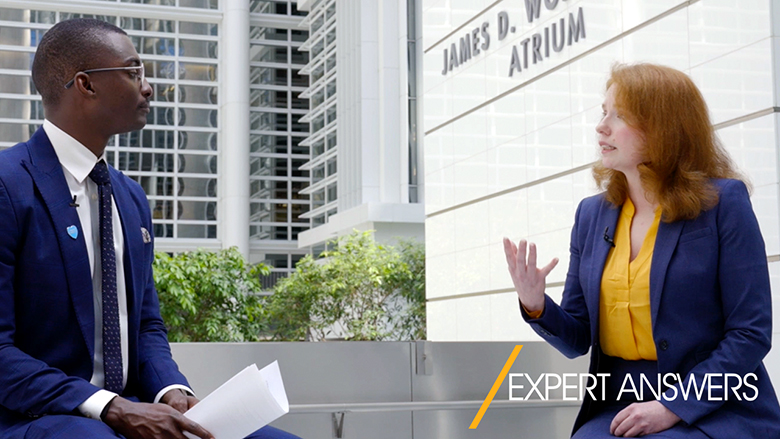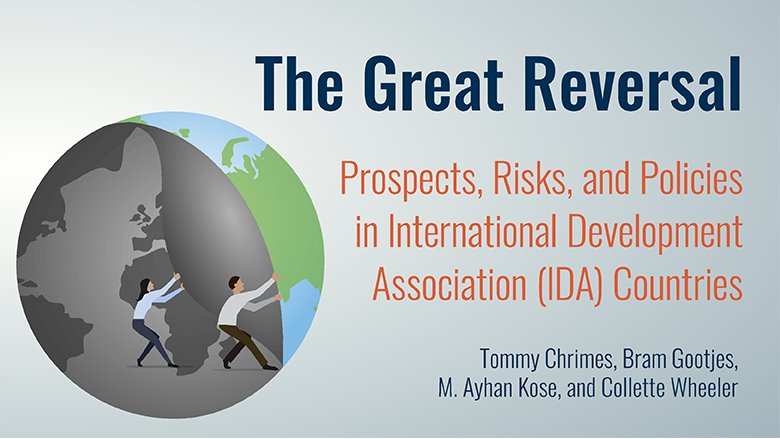A historic reversal is underway in the 75 most vulnerable economies eligible for grants and zero to low-interest loans from the World Bank’s International Development Association (IDA). Half of IDA countries, are experiencing a widening income gap with the wealthiest economies for the first time in this century. To help us learn how this ‘great reversal’ can be halted, World Bank Group Senior Economist, Collette Wheeler joins Expert Answers.
Timestamps
00:00 Introducing the topic and expert
01:44 The great reversal: Why it is happening now?
04:07 Challenges and opportunities ahead
05:49 Policy reforms and investments needed
08:56 The importance of global assistance

Transcript
[00:00] - Progress is possible. We've had three dozen countries graduate from IDA, one dozen of which has been since 2000, and some of these countries are key engines to the global economy.
- Hello, and welcome to "Expert Answers." I'm Samuel Owusu Baafi. As Martin Luther King Jr once said, "Human progress is neither automatic, nor inevitable." Today, we'll be looking at a historic reversal underway in the fortunes of 75 of the most vulnerable economies in the world. Gains in poverty alleviation and income have turned to losses. These same 75 countries are eligible for grants and zero to low-interest loans from the World Bank's International Development Association, also known as IDA. The funding for those grants and loans is being replenished this year. These so-called IDA countries are home to 1.9 billion people, a quarter of humanity. And in half of these countries, the income gap with the wealthiest economies in the world is widening for the first time this century. So we need to act, but what can be done to halt what the World Bank has labeled a great reversal? Let's find out. I'm joined by Collette Wheeler, who's a senior economist of the World Bank. She's also a co-author of "The Great Reversal: Prospects, Risks and Policies in International Development Association Countries." Welcome, Collette to "Expert Answers."
- Thank you, Sam. It's a pleasure to be here.
[01:44] - Great. So let's get things started. Can you give us a little more context on the reversal underway, and why it's happening now?
- Yeah, sure. So actually it's really first important to mention that prior to the pandemic, IDA countries had actually made a lot of progress in their development goals in terms of income gains as well as reducing extreme poverty rates. However, the pandemic as well as other shocks that happened to the global economy, including heightened geopolitical conflict, and violence, rising inflation, as well as increases in interest rates and tighter financing condition, all these shocks interrupted that progress that we had seen prior to the pandemic in these countries. Also, the pandemic exacerbated many of the preexisting challenges that these IDA countries were facing, including debt. Also, food insecurity was a major concern prior to the pandemic, and all these other global shocks, that became worse in light of increased violence and conflict, as well as the increase in food prices. We also saw an erosion in human capital from the pandemic. What all this has meant is that we've seen a reversal in the development progress we had once had prior to the pandemic. So growth in these countries over the half decade of 2020 to 2024 is actually on course to be the weakest that we've seen since the 1990s. What that reversal has meant is that instead of incomes catching up to advanced economy levels like we would usually expect, they've instead have reversed in about half of IDA countries. This is the largest share of IDA countries we've seen facing this since the start of this century. So one in three IDA countries remains poorer now than it was on the eve of the pandemic in per capita income terms, and we lost about three years of poverty reduction progress. So what this has all meant is that we are seeing a great reversal underway in IDA countries, and if growth remains on this low trajectory, we could actually witness a lost decade in development.
[04:07] - Oh, wow. Well, that's a pretty dire picture, but what opportunities are there to arrest this slide, and why is it important for not just the countries we're talking about here today, but for all of us?
- Yeah, so although there are great challenges, there's actually really large, an enormous, actually, potential growth in IDA countries. And that could, if they can leverage, and harness this potential growth that they have, they could help stem these losses. And there's two really important areas for IDA countries that they could use to leverage this potential. The first one is the natural resources. They are quite abundant in those, and many of them have natural resources that are critical for the energy transition in terms of critical minerals. The second important factor is that IDA countries have a relatively young population, so they have favorable demographic trends. And in other countries, we are actually expecting working age populations to either flatten, or shrink, or decline even, over the coming decades, where in IDA countries, we're actually expecting that to increase. Our research has shown that a one percentage point increase in the working age population can yield a one to 3% increase in GDP per capita. So there is enormous potential in these countries if they can harness that. Now, why are they so important? Well, everyone should care about reducing poverty and increasing living standards globally to enhance prosperity, and stability, and peace.
[05:49] - That's exciting. And it sounds like the building blocks to reverse or to stop this slide exist. What do the IDA countries need to do to fully, fully, you know, grasp this potential?
- Right, so they really need to enact and enable ambitious domestic policy reforms. There are many investment needs in these countries, so policies that are centered around boosting investment and longer-term growth will be critical. Of course, every country will require its own specific package and sequencing of these policies. On the fiscal side, for revenues, we could think about enhancing the mobilization. So aligning tax rates, looking at strengthening tax administration. On the expenditure side, we could look at increasing expenditure efficiency, especially because many of these IDA countries actually lag other countries in this respect. So then they would be able to move their spending toward growth-enhancing measures that could ultimately boost their economies. Social protection packages will also be key to protect the most vulnerable, and ensure an inclusive recovery from all these global shocks. But also fiscal rules can help anchor credibility. Now, on the monetary policy side, it'll be critical for policy makers to remain focused on maintaining, containing inflation. They may need to tighten. Once again, this is not IDA-specific. Many countries in the world have faced these pressures, but what is unique to IDA countries is that many of them are actually on a fixed exchange rate regime. So for those IDA countries, it'll actually be important for them to align their fiscal policies to their monetary as well, to ensure that reserves remain adequate, and that their currency regime remains credible. All this will be really important to maintain price stability, as well as to anchor those longer term inflation expectations. Now, on the structural side, I mentioned that investment's going to be really important. So creating the environment that is conducive to that will be really helpful for these countries to attract that investment, especially from the outside. So improving and strengthening institutions is one area of reform. Another area of structural reform that we could consider is on the human capital side, especially after the pandemic eroded, some of the learning that, gains we had had earlier, and also on the health side, that will require investments, however. And then the third structural policy I'll mention is dismantling the barriers that exist in labor markets so that women, the youth, and other groups can participate fully, and get productive jobs in the economy.
[08:56] - So this, it's very hopeful, right? And it paints a really bright picture with all these reforms that are possible. Now, as we look forward to the replenishment of IDA at the end of the year, can you highlight the importance of global assistance and how it can help turn the tide on this reversal?
- Absolutely. So global assistance is going to be critical for IDA countries to harness their full potential. There are two big points here. One, investment needs are really, have increased since the pandemic, and these subsequent shocks. And two, history shows us that progress and development is possible, including from global support. So on the first point, we've seen a historic setback in development progress, in many countries, including in IDA countries. And really, that's going to take the global community's support to help these countries enact those reforms that are needed, especially when you consider that development, infrastructure, and climate resilience goals will cost about 10% of GDP per year over the remainder of the decade in the poorest of IDA countries. That's an enormous number that they just simply can't achieve on their own. And to the second point, history shows us that this progress is possible. We've had three dozen countries graduate from IDA, one dozen of which has been since 2000. And some of these countries are key engines to the global economy, the Republic of Korea, China, and India. So these examples really show us that with global support, that it is possible to achieve these goals and realize their full potential.
- That's amazing. Thank you, Collette.
- Thank you very much, Sam.
- Thanks again to Collette for joining me on "Expert Answers." Check out the research and publications page of the World Bank website to learn more about everything we've spoken about today. Goodbye.


